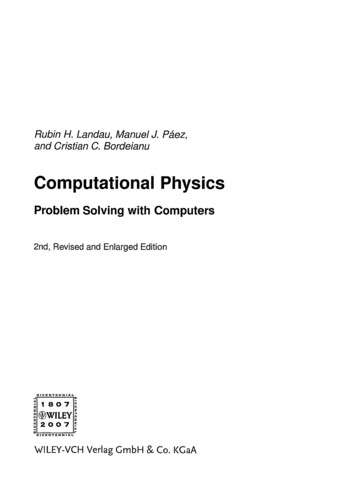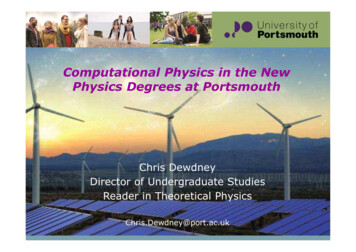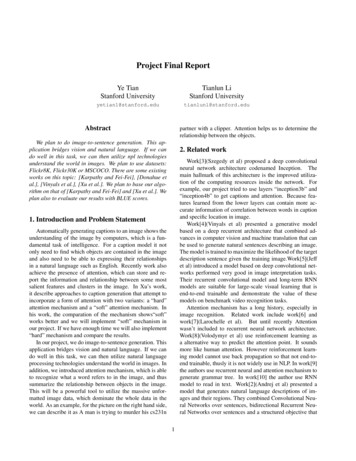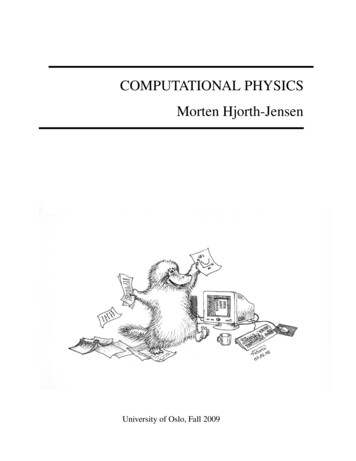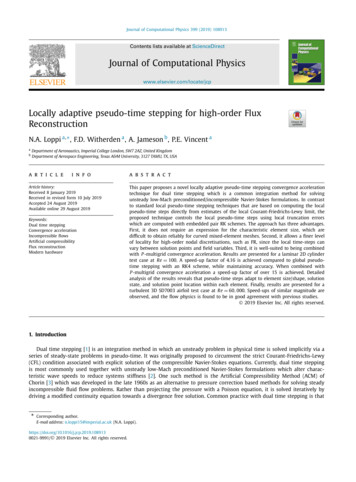
Transcription
Journal of Computational Physics 399 (2019) 108913Contents lists available at ScienceDirectJournal of Computational Physicswww.elsevier.com/locate/jcpLocally adaptive pseudo-time stepping for high-order FluxReconstructionN.A. Loppi a, , F.D. Witherden a , A. Jameson b , P.E. Vincent aabDepartment of Aeronautics, Imperial College London, SW7 2AZ, United KingdomDepartment of Aerospace Engineering, Texas A&M University, 3127 TAMU, TX, USAa r t i c l ei n f oArticle history:Received 8 January 2019Received in revised form 10 July 2019Accepted 24 August 2019Available online 29 August 2019Keywords:Dual time steppingConvergence accelerationIncompressible flowsArtificial compressibilityFlux reconstructionModern hardwarea b s t r a c tThis paper proposes a novel locally adaptive pseudo-time stepping convergence accelerationtechnique for dual time stepping which is a common integration method for solvingunsteady low-Mach preconditioned/incompressible Navier-Stokes formulations. In contrastto standard local pseudo-time stepping techniques that are based on computing the localpseudo-time steps directly from estimates of the local Courant-Friedrichs-Lewy limit, theproposed technique controls the local pseudo-time steps using local truncation errorswhich are computed with embedded pair RK schemes. The approach has three advantages.First, it does not require an expression for the characteristic element size, which aredifficult to obtain reliably for curved mixed-element meshes. Second, it allows a finer levelof locality for high-order nodal discretisations, such as FR, since the local time-steps canvary between solution points and field variables. Third, it is well-suited to being combinedwith P -multigrid convergence acceleration. Results are presented for a laminar 2D cylindertest case at Re 100. A speed-up factor of 4.16 is achieved compared to global pseudotime stepping with an RK4 scheme, while maintaining accuracy. When combined withP -multigrid convergence acceleration a speed-up factor of over 15 is achieved. Detailedanalysis of the results reveals that pseudo-time steps adapt to element size/shape, solutionstate, and solution point location within each element. Finally, results are presented for aturbulent 3D SD7003 airfoil test case at Re 60, 000. Speed-ups of similar magnitude areobserved, and the flow physics is found to be in good agreement with previous studies. 2019 Elsevier Inc. All rights reserved.1. IntroductionDual time stepping [1] is an integration method in which an unsteady problem in physical time is solved implicitly via aseries of steady-state problems in pseudo-time. It was originally proposed to circumvent the strict Courant-Friedrichs-Lewy(CFL) condition associated with explicit solution of the compressible Navier-Stokes equations. Currently, dual time steppingis most commonly used together with unsteady low-Mach preconditioned Navier-Stokes formulations which alter characteristic wave speeds to reduce systems stiffness [2]. One such method is the Artificial Compressibility Method (ACM) ofChorin [3] which was developed in the late 1960s as an alternative to pressure correction based methods for solving steadyincompressible fluid flow problems. Rather than projecting the pressure with a Poisson equation, it is solved iteratively bydriving a modified continuity equation towards a divergence free solution. Common practice with dual time stepping is that*Corresponding author.E-mail address: n.loppi15@imperial.ac.uk (N.A. 21-9991/ 2019 Elsevier Inc. All rights reserved.
2N.A. Loppi et al. / Journal of Computational Physics 399 (2019) 108913the physical time is discretised with a Backward Difference Formula (BDF) scheme, and the pseudo-time problem is solvedeither explicitly or implicitly.There have been various attempts to apply the ACM in a high-order context. Bassi [4] first succeeded in applying theapproach with a Discontinuous Galerkin (DG) scheme to solve steady incompressible flow problems. Later, Liang et al.[5] extended the method to Spectral Difference (SD) schemes in 2D, providing support for unsteady flows via dual timestepping. Recently, Cox et al. [6] successfully applied the method with Flux Reconstruction (FR) in 2D, and introduced afully implicit pseudo-time stepping strategy. In the current study, we utilise the cross-platform high-order ACM solver withFR developed by Loppi et al. [7] in the Python-based open-source PyFR framework. The solver supports a range of computerarchitectures, from laptops to the largest supercomputers, via a platform-unified templating approach that can generate andcompile CUDA, OpenCL and C/OpenMP code at runtime. In the solver, pseudo-time stepping is performed explicitly withP -multigrid convergence acceleration. The choice of explicit methods is motivated by current trends in modern hardware;most notably an abundance of compute capability relative to memory bandwidth, extensive parallelism, and low memoryper core. Using explicit schemes, the majority of operations can be cast as matrix-matrix multiplications with minimalcommunication, whereas implicit methods require computation of large flux Jacobians and significant memory indirectiondue to inter-element couplings.The efficiency of dual time stepping depends strongly on the rate at which pseudo iterations converge within eachphysical time step. A popular explicit convergence acceleration technique is local pseudo-time stepping, which allows thepseudo-time step size to vary between elements. The majority of current local pseudo-time stepping approaches are basedon identifying the maximum locally stable time step directly from a local CFL number, calculation of which requires anestimate of the local characteristic element size. For unstructured grids the definition of the characteristic element size isoften based on heuristics. Two popular definitions are the radius of an inscribed sphere or the distance to the elementboundary along a streamline [8,9]. In this study, a new alternative approach based on adaptive error control via embeddedpair RK schemes is proposed. The main advantage of this approach is that it does not require computing characteristicelement sizes which can be difficult to obtain reliably for high-order curved unstructured grids of mixed element types. Inaddition, the approach allows a finer level of locality, as the local time-steps can vary between solution points and fieldvariables. Due to its nodal nature, it is also well-suited to work with P -multigrid convergence acceleration, since the pseudotime-step sizes can be locally projected onto different solution bases in the P -multigrid cycle.The paper is structured as follows. Sections 2 and 3 provide brief summaries on the FR discretisation and relevant timeintegration techniques. Section 4 introduces the unsteady artificial compressibility method for computing incompressibleflows with FR using dual time stepping. Section 5 details the proposed locally adaptive pseudo-time stepping approach,including P -multigrid acceleration, and introduces an implementation in the open-source PyFR framework. In Section 6, theperformance is assessed with a 2D cylinder test case, and the underlying adaptation mechanisms are analysed. In Section 7,the technology is applied to a SD7003 airfoil simulation to demonstrate its utility for turbulent flow problems. Finally,conclusions are drawn in Section 8.2. Flux ReconstructionFlux Reconstruction method unifies nodal DG and SD schemes within a single framework. It was first introduced byHyunh for advection in [10] and for diffusion in [11]. A summary of the FR formulation for mixed unstructured grids isgiven below. More detailed presentations can be found in [12–14]. Consider a finite solution domain in Euclidean spaceR N D with a coordinate system x xi R N D , where N D is the number of dimensions. A conservation law in the domaintakes the form uα · fα , t(1)where u α u α (x, t ) is the solution state for a field variable α and fα fα (u α , uα ) is the associated flux. The domain isdiscretised using a set of suitable element types ε , such as line elements in N D 1, quadrilaterals and triangles in N D 2,and hexahedra and tetrahedra in N D 3. The elements in the discretised domain must conform according to e ,e ε e e n 1 en , e en ,(2)e ε n 1where the subscript e refers to an element type and e is the number of elements of that type.For efficient numerical implementation, all operations are performed in a transformed space with a coordinate system e R N D via a vectorx̃ x̃i R N D . Each physical element e is mapped into its respective transformed standard element mapping function Mi as 1x̃i Meni(x) ,(3)xi Meni (x̃) ,(4)
N.A. Loppi et al. / Journal of Computational Physics 399 (2019) 1089133where i denotes the spatial component of the mapping function. The Jacobian matrices and determinants associated withthe mapping are defined as 1 Meni 1 1Jen J eni ,j xj 1 1Jen det Jen 1JenJen J eni j Meni, x̃ j(5)Jen det Jen ,,(6)where j denotes the spatial component of the derivative. Using the above relations, the transformed flux and transformedgradient of the solution can be written as a function of the physical solution as 1f̃enα (x̃, t ) Jen (x̃)Jen(Men (x̃))fenα (Men (x̃), t ) ,(7)T u enα (x̃, t ) Jen (x̃) uenα (Men (x̃), t ) ,(8) / x̃i . Moreover, Equation (1) can be expressed in terms of the transformed divergence of the transformed fluxwhere as u enα 1 · f̃enα . Jen t(9)In the FR method, piece-wise discontinuous polynomials of order P are used to represent the solution within eachuelement. Take {x̃ei} to be a set of solution points associated with a given standard element type, where 0 i N e , with N ebeing the number of solution points. Examples of such point distributions are Gauss-Legendre or Gauss-Lobatto points, whenN D 1, Witherden-Vincent points [15] for triangles, when N D 2, and Shunn-Ham points [16] for tetrahedra, when N D u3. The set of solution points {x̃ei} can be used to define a nodal basis set {lei (x̃)} of order P ( N e ) that spans a polynomialspace P and satisfies the property lei (x̃euj ) δi j . Following the methodology in [17], the nodal basis can be formed byfirst defining any modal basis set { L ei (x̃)} that spans P , and calculating the entries in the associated Vandermonde matrixVei j L ei (x̃euj ). Subsequently, a nodal basis can be constructed as lei (x̃euj ) Vei j1 L e j . In addition to the solution points, afffset of element-type-specific flux points {x̃i }, where 0 i N e , with N e being the number of flux points, are definedat the element interfaces. Each element interface, apart from those at the domain boundaries, contain the flux points oftwo neighbouring elements. For a given flux point pair ei j and e i j , the mapping function must return the same physicallocation according toffMen (x̃ei ) Me n (x̃e i ) .(10)For computing the right-hand-side, the first step is obtaining the discontinuous solution at the flux points from theinterpolating solution polynomial asffu einα u eujnα le j (x̃ei ) .(11)These values are used to find a common interface solution at the flux points via a scalar function C (u L , u R ), where thesuperscripts R and L denote the right and left states respectively. The common values are assigned asffffC u einα C u e i n α C (u einα , u e i n α ) .(12)The second step is to compute the gradient of the solution at the solution points. For this purpose, we form a vectorfcorrection function gei (x̃) which satisfiesˆ e j · g (x̃ ) δi j ,ñei e jff(13)ˆ e j is the outward facing normal vector. This allows the transformed gradient of the solution at the solution pointswhere ñto be computed as u u u ñˆ · g f (x̃u ){C u f u f } u u einαeknα lek (x̃ei ) ,e j eie jnαe jnαej(14)which transforms into physical space as T uu ueinα Jein u einα ,(15) T T (x̃ ). As a third step, the transformed flux at the solution points is evaluated aswhere Jein Jenei 1uuuf̃einα Jein Jein fα (u einα , ueinα ) ,(16)
4N.A. Loppi et al. / Journal of Computational Physics 399 (2019) 108913and the normal component of the transformed flux at the flux points asˆ ei · f̃u .f̃ einα le j (x̃ei )ñe jnαf f(17)The fourth step is to compute the common normal fluxes at the flux point pairs with a function Fα (u L , uL , u R , uR , n̂),that comprises of performing a Riemann solve for the inviscid part and using the LDG approach for the viscous part. Thecommon values are assigned asf f ffffFα f einα Fα f e i n α Fα (u ein , uein , u e i n , ue i n , n̂ein ) ,(18)whereff ueinα le jn (x̃ei ) ueujnα ,(19)and they are transformed into the standard element space viaf f fFα f̃ einα Jein nein Fα f einα ,(20)with nein being the magnitude of the physical normal at a flux point. Finally, the divergence of the continuous flux can becomputed with a procedure analogous to Equation (14), as u · f̃ einα · g f (x̃u ){Fα f̃ f f̃ f } f̃u · lek (x̃u ) . eieknαe j eie jnαe jnα(21)This serves as the discrete representation of the flux divergence, and the solution can be in advanced in time by integrating u einα J 1 tuein u · f̃ einα(22).3. Time-integration3.1. Explicit Runge-Kutta schemesConsider an ODE of the formdu g (t , u ) .dt(23)Explicit Runge-Kutta (RK) methods for solving Equation (23) can be written in the general formun 1 un tsb i ki ,(24)i 1i 1ki g (t c i t , un tai j k j ) ,(25)j 1where s is the stage count, A ai j is an s s strictly lower triangular matrix, and b b i and c c i are vectors of length s.The coefficients of a generalised explicit RK scheme are typically presented in a Butcher tableau [18]cA.b(26)The constraints for an explicit RK scheme aresci ai j ,(27)j 1sbi 1 ,(28)a i j 0, j i .(29)i 1By applying an RK scheme to a linear test problem g (t , u ) ωu, wherescheme can be defined directly from the Butcher tableau asP (s,q) ( z) 1 zb T (I zA) 1 e I zA zebT . I zA ω C , the stability polynomial of an explicit RK(30)
N.A. Loppi et al. / Journal of Computational Physics 399 (2019) 1089135Table 1Butcher tableau of the RK3(2)4[2R ] embedded pair represented as (a) rational(4,3)coefficients and (b) real coefficients, where the first rows of b are the b icoefficients resulting in third order temporal accuracy and the second rows are the(4,2)bicoefficients resulting in second order 9313685301971492346793006927 301938519399429696342944c i A i ,i 1 i 2j 1 10116974636329037734290219643 6954496478895530262026368149(4,3) b j 2 , 2 i 4(b)0c2c3c40.32416573882870.1040798692751 0.5570978645060.1040798692751 0.601939136882 0.086054914313(4,3)bi0.104079869275 0.601939136882(4,2)bi0.340681484081 0.090915230086c i A i ,i 1 i 2j 12.9750900268842.866496742725 2.681109033041 2.298093456893(4,3) b j 2 , 2 i 4where z ω t, e is a vector of ones, and the superscript q denotes the temporal order of the scheme. The stability regionS of the RK scheme is S z C : P s, p 1 ,(31)with the linear stability condition being t ω S .(32)Embedded RK pairs are a family of RK schemes of consecutive temporal orders q and q 1 for which A are equal. Thisproperty allows the temporal truncation error of the embedded pair to be estimated ass(s,q)ξ(t t ) t(bi(s,q 1) bi)ki .(33)i 1For a given truncation error tolerance, the time-step size can be controlled such that the scheme remains stable. This procedure will be detailed in Section 5. The Butcher tableau of the RK3(2)4[2R ] scheme [19] used in the numerical experimentsis shown in Table 1. The naming convention follows that of [19]. The first digit denotes the temporal order-of-accuracy ofthe higher order scheme followed by the temporal order-of-accuracy of the lower order scheme in parentheses. The thirddigit is the number of stages and the final string in square brackets describes the number of registers required when thescheme is implemented using the van der Houwen formulation [19].3.2. Implicit Backward Difference Formula schemesBDF schemes are a range of implicit multistep methods that can be formulated asu n 1 s 1B i 1 un i t B 0 g (t n 1 , un 1 ) ,(34)i 0where B i are the BDF-coefficients. Table 2 shows the BDF-coefficients for the most commonly used schemes. The stabilitypolynomial of BDFs can be defined ass 1B i 1 ξ i (1 B 0 z)ξ s .P ( z) i 0(35) The stability condition is that all roots of the stability polynomial lie in the region z C : ξ 1 . The BDF schemes areA-stable up to 2nd order. With higher order BDFs, two unstable regions form near the real axis. However, these regionsare very small for the third order accurate BDF3, meaning it is still stable for a wide range of z. Moreover, it has beensuccessfully applied to unsteady flow simulations [20].
6N.A. Loppi et al. / Journal of Computational Physics 399 (2019) 108913Table 2Coefficients for the BDFs.Backward-EulerBDF2B0B1B2B31 1 43–––23611BDF3 1811139112 114. Unsteady Artificial Compressibility Method with dual time steppingIn the ACM formulation of the incompressible Navier-Stokes equations, the conservative variables in three dimensionsareuα p vxvy (36),vzwhere p is the pressure and v x , v y , and v z are the velocity components in the x, y, and z directions, respectively. Thefluxes are defined as e fα x fα f αe y efα z where f αv x f αv y , f αv z(37) ζvy ζ vx ζ vz 2 v v vz vxvx py xeee, fα y , fα z ,fα x 2vzv y v p v v x y y 2vxvzvz pv y vz 0 00 vx vx vx yvvv x zfα x ν v y, fα y ν v y , fα z ν v y , y z x vz vz vz x(38)(39) z ywith ζ being the artificial compressibility relaxation factor and ν the kinematic viscosity.The ACM formulation of the incompressible Navier-Stokes equations is hyperbolic in nature, allowing artificial pressurewaves with finite speeds. These waves distribute the pressure and disappear in the limit of pseudo steady state. Eigenvaluesof the inviscid flux Jacobian matricesJi f αe i, u(40)areλi { v i c i , v i , v i , v i c i } ,where c i (41)v 2i ζ is the pseudo speed of sound, and i {x y z}. The pseudo speed of sound monotonically decreases withdecreasing artificial compressibility relaxation factor ζ which can be adjusted to reduce the system stiffness. The commoninterface flux in this study is computed asFα (u L , uL , u R , uR , n̂) Fαe (u L , u R , n̂) Fαv (u L , uL , u R , uR , n̂) ,(42)where Fα is the Rusanov Riemann solver [21] and Fα together with C (u L , u R ) are defined according to the local discontinuous Galerkin (LDG) approach in [17].The dual time stepping formulation applied to the artificial compressibility equations can be written ase uα uα Ic · fα , τ tv(43)where u α / τ is a pseudo time derivative which is marched towards zero with a Runge-Kutta scheme, and Ic u α / t is thephysical time derivative which is discretised using a BDF scheme. A cancellation matrix Ic diag{0 1 1 1} is employed as
N.A. Loppi et al. / Journal of Computational Physics 399 (2019) 1089137a coefficient for the physical time derivative to eliminate it from the continuity equation, forcing the solution to be driventowards a divergence free state according to limτ vz vx v y 0. x y z(44)When the solution is integrated with respect to pseudo time, the physical time derivative can be considered as a sourceterm for the right-hand side that is updated at every step. For example, with a BDF2 discretisation the equations forperforming a single pseudo-time step becomesunα 1,m 1 unα 1,m s τ b ii 1ki · fα (unα 1,m ταPIki ,i 1ai j ki ) j 1(45)Ic t B 0unα 1,m B 1 unα B 2 unα 1 ,(46)where τ is the pseudo-time step, n is the physical time-level counter, m is the pseudo-time level counter, and αPI 1 b i τ / B 0 t is a scaling coefficient which limits τ if τ t. With explicit pseudo-time steppers this is rarely thecase and αPI 1 is enforced in this study.After each pseudo-step, m is incremented by one. Pseudo-steps are repeated until the solution in physical time is deemedto have converged. Convergence criteria include that the point-wise L 2 , or L norm of the residuals are satisfied up to agiven tolerance, or a maximum number of pseudo-time steps have been exceeded. After each pseudo-time cycle, m isrestarted from zero, and n is incremented by one.5. Locally adaptive pseudo-time stepping5.1. OverviewThe efficiency of the dual time stepping algorithm depends on fast convergence of the pseudo steady-state process. Thedisadvantage of using explicit schemes in pseudo-time is that their stability region is limited by the CFL number makingthem inefficient at eliminating low frequency error modes on fine grids [22]. The issue can be addressed by adoptingimplicit schemes to allow much larger pseudo-time steps [6]. However, the trade-off with implicit schemes is that theirmemory bandwidth and storage requirements are significantly higher due to the flux Jacobian matrices. This is known to bea challenge especially for modern hardware architectures, such as GPUs, that are characterised by an abundance of computecapability relative to memory bandwidth, extensive parallelism, and low memory per core. In addition, many methods forsolving the resulting linear system, such as LU-SGS or ILU-GMRES, are not scale invariant and increasing the amount ofparallelism tends to reduce their numerical effectiveness.Local pseudo-time stepping is a widely-used technique for accelerating steady-state convergence explicitly [23,24,2]. Themajority of current local pseudo-time stepping approaches compute the local pseudo-time step for element n of type e fromthe hyperbolic CFL criterion as τen henmax( λi en ),(47)where hen is the characteristic length of the element, and max( λi en ) is the local spectral radius of the inviscid flux Jacobian.For viscous dominated flows it is also necessary to consider the parabolic CFL limit defined as τen 2hen2μ,(48)where μ ρν , with ρ being the density for compressible Navier-Stokes formulations. Definition of h is often based onheuristics and it can have a considerable effect on the performance and accuracy of local time stepping as shown in [25].With unstructured grids two popular definitions are the radius of an inscribed sphere or the distance to the elementboundary along a streamline [8,9].5.2. MethodologyAs an alternative to the current approaches, a local pseudo-time stepping technique based on adaptive error control withembedded pair RK schemes is proposed. The main advantage of the technique is that it does not require an expression forthe characteristic element size which is difficult to obtain reliably for curved mixed-element meshes. It also allows a finerlevel of locality for high-order nodal discretisations, such as FR, since the local time-steps can vary between solution points
8N.A. Loppi et al. / Journal of Computational Physics 399 (2019) 108913and field variables. Additionally, it is well-suited work with P -multigrid convergence acceleration since the pseudo-timesteps can be locally projected onto different solution bases.Embedded pair RK schemes give two approximations of the solution at the next time level, each depending on a differentset of b coefficients. In pseudo-time, the difference between these two approximations, often called a truncation error, canbe approximated ass(s,q)ξeujnα (τ τeujnα ) τeujnα(bi(s,q 1) bi)kuie jnα(49)i 1for a field variable α at solution point j within element n of type e. In the current study, the local pseudo-time steps τeujnαwill be controlled such that the truncation error remains small, and the method remain stable. Specifically, a normalisederrorσeujnα ξeujnα (τ τeujnα )κis kept close to unity, whereputed as,(50)κ is an error tolerance. With a PI-controller the pseudo-time step adjustment factor is com- φ/q χ /q( f PI )eujnα f safe σeujnα,(σprev )eujnα(51)where φ , are χ are PI-controller parameters, f safe is a safety factor, and the subscript prev denotes the error computed atthe previous pseudo-time step. For improved robustness, the pseudo-time step adjustment factor is limited by minimumand maximum adjustment factors f min and f max asf eujnα min( f max , max( f min , ( f PI )eujnα )) .(52)The new pseudo-time step is computed as( τnew )eujnα min( τmax , max( τmin , f eujnα τeujnα )) ,(53)with absolute minimum and maximum pseudo-time step limits τmin and τmax , and where τmin also serves as an initialguess for the pseudo-time step sizes. In this work, the maximum pseudo-time step limit is defined as τmax f τ τmin ,where f τ is the maximum factor by which the pseudo-time steps are allowed to grow.The approach differs from physical time-step adaptation in several ways. First, in physical time-step adaptation the PIcontroller controls only a single global physical time-step value which is computed from the point-wise error with a norm,such as L 2 or L , over all element types, elements, solution points, and field variables. In locally adaptive pseudo-timestepping, all operations are kept completely local and independent for each element type, element, solution point, and fieldvariable. Second, in physical time-step adaptation it is common practice to reject steps that violate error tolerance requirements, and retake them with a smaller step size. In locally adaptive pseudo-time stepping, retaking steps is unnecessary aslong the they remain stable because time accuracy is not required.In all, the locally adaptive pseudo-time stepping approach is parameterised by eight quantities, κ , φ , χ , f safe , f min , f max , τmin and f τ . Appropriate selection of κ , φ , χ , f safe , f min and f max is based on the characteristics of the controller ratherthan specifics of a particular simulation. Values of φ 0.4, χ 0.7, κ 10 6 , and f safe 0.8 are used throughout the studyand they are the default values in PyFR. They have been found empirically to work well, and are similar to those used inglobal physical time-step control [26,27,18]. The minimum and maximum adjustment factors f min and f max should be setconservatively e.g. f min 0.98 and f max 1.01 to ensure smooth variation of the local pseudo-time step sizes.5.3. Combining with P -multigridTo further accelerate the pseudo-steady-state convergence, error-estimate-based locally adaptive pseudo-time steppingcan be coupled with a P -multigrid [22,5]. The P -multigrid technique (perhaps better referred to as multi- P ) attempts tocircumvent the strict CFL limit when solving the pseudo-time problem explicitly by correcting the solution at differentpolynomial levels. Without altering the computational grid, low order representations of the solution, which exhibit a lessrestrictive CFL limit, can be used to propagate information with a larger τ . Another property of P -multigrid is that whenthe solution is projected to a lower order space, the low frequency error modes appear as higher frequencies respective tothe resolution, which allows explicit steppers to eliminate them more effectively.Initially, two different approaches for combining P -multigrid were studied. The first approach let all P -multigrid levelsperform the pseudo-time step control independently of each other. Despite its potential for being fully automated, it lackedrobustness in finding the local pseudo-time steps at the intermediate levels and was therefore discarded. The second approach that was studied performs the pseudo-time step control only at the highest level and the local pseudo-time steps are
N.A. Loppi et al. / Journal of Computational Physics 399 (2019) 1089139projected onto different bases locally. Additionally, the projected values at lower levels are increased with a user-specifiedscaling factor due to less restrictive CFLs. The second approach was found to be superior in terms of robustness, and it alsohas a smaller memory footprint and computational overhead, since only the highest level performs the pseudo-time stepadaptation.Dual time stepping with P -multigrid follows the procedures detailed in Section 4 with the difference that an additionalsource term arising from a lower order representation of the solution is added to Equation (43). The spatially discrete formof the governing equation isu u einlαuu R einlα reinlα , τ(54)whereu 1R einlα Jueinl u · f̃ einlα Icu u einlα, t(55)with l denoting the P -multigrid level and reinlα being the additional source term which is zero when l P . A singleP -multigrid V-cycle with locally adaptive pseudo-time stepping at the highest level can be performed according to Algorithm 1. The P -multigrid cycle should be set such that it goes down to P 0, and the number of smoothing iterationsshould be increased at l 0 and at l P during post-cycle smoothing.In this work, the restriction operator I r is constructed using the generalised Vandermonde matrix asI r ατ VelT Ĩ Vel T ,(56)uwhere Vel L eil (x̃eujl ), Vl L eil (x̃le), with l denoting the level onto which the solution is projected, and Ĩ is an non-squarejmatrix of zeros, except on its main diagonal, where it has entries of one. The leading coefficient ατ is a pseudo-timestep expansion factor, which is unity except when applying the restriction operator to local pseudo-time steps. In thosecases it takes a value greater than unity to increase the local pseudo-time steps sizes at lower P-multigrid levels. Theapproa
N.A. Loppi et al. / Journal of Computational Physics 399 (2019) 108913 the physical time is discretised with a Backward Difference Formula (BDF) scheme, and the pseudo-time pr
